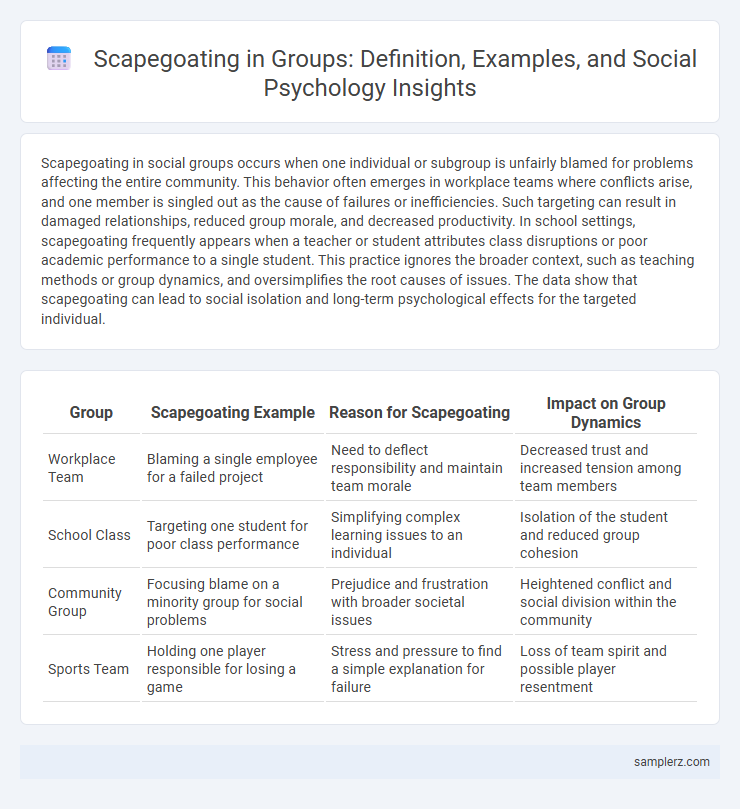Scapegoating in social groups occurs when one individual or subgroup is unfairly blamed for problems affecting the entire community. This behavior often emerges in workplace teams where conflicts arise, and one member is singled out as the cause of failures or inefficiencies. Such targeting can result in damaged relationships, reduced group morale, and decreased productivity. In school settings, scapegoating frequently appears when a teacher or student attributes class disruptions or poor academic performance to a single student. This practice ignores the broader context, such as teaching methods or group dynamics, and oversimplifies the root causes of issues. The data show that scapegoating can lead to social isolation and long-term psychological effects for the targeted individual.
Table of Comparison
| Group | Scapegoating Example | Reason for Scapegoating | Impact on Group Dynamics |
|---|---|---|---|
| Workplace Team | Blaming a single employee for a failed project | Need to deflect responsibility and maintain team morale | Decreased trust and increased tension among team members |
| School Class | Targeting one student for poor class performance | Simplifying complex learning issues to an individual | Isolation of the student and reduced group cohesion |
| Community Group | Focusing blame on a minority group for social problems | Prejudice and frustration with broader societal issues | Heightened conflict and social division within the community |
| Sports Team | Holding one player responsible for losing a game | Stress and pressure to find a simple explanation for failure | Loss of team spirit and possible player resentment |
Understanding Scapegoating: Social Group Dynamics
Scapegoating occurs when a social group singles out an individual or subgroup to blame for broader problems, often to deflect responsibility from themselves. This mechanism helps maintain group cohesion by uniting members against a common "enemy," despite underlying complex issues. Understanding scapegoating reveals how social identity theories and in-group/out-group biases drive exclusion and conflict within communities.
Historical Examples of Scapegoating in Society
Throughout history, scapegoating has often targeted minority groups during times of social crisis, such as the persecution of Jews during the Black Death in 14th-century Europe. In the United States, Japanese Americans faced scapegoating and internment during World War II due to wartime fears and racial prejudice. These examples illustrate how societies have used marginalized groups as convenient targets to deflect blame and maintain group cohesion amid uncertainty.
Scapegoating in the Workplace: Real-World Cases
Scapegoating in the workplace often manifests when one employee is unfairly blamed for team failures, as seen in cases where managers single out individuals to deflect responsibility from higher-ups. Real-world examples include the Boeing 737 Max crisis, where engineers were blamed for design flaws despite systemic organizational issues. This practice undermines trust, damages morale, and perpetuates toxic work environments.
School Settings: Students as Scapegoats
In school settings, scapegoating often targets students who differ from the majority, such as those with learning disabilities or unique cultural backgrounds, unfairly blaming them for group conflicts or academic failures. Teachers and peers may label these students as troublemakers or underachievers, exacerbating social isolation and negatively impacting their self-esteem. This dynamic highlights the importance of promoting inclusive environments and addressing biases to ensure equitable treatment for all students.
Family Systems and the Role of the Scapegoat
In family systems, scapegoating occurs when one member is unfairly blamed for conflicts or dysfunctions, diverting attention from underlying issues. The scapegoat often exhibits problematic behaviors, reinforcing their role while masking deeper relational problems within the family structure. This dynamic preserves family homeostasis by externalizing internal tensions onto a single individual, hindering genuine communication and resolution.
Political Movements: Groups Blaming Minorities
Political movements have historically scapegoated minorities to unify supporters by creating a common enemy, often attributing societal problems like economic downturns or crime rates to these groups. For instance, during the rise of fascism in 20th-century Europe, minority communities such as Jews were falsely blamed for national hardships, fueling discrimination and violence. Such scapegoating tactics manipulate public opinion, consolidate power, and marginalize vulnerable populations within the social fabric.
Scapegoating in Online Communities
Scapegoating in online communities often manifests as targeting specific users or groups for blame during conflicts or technical issues, regardless of actual responsibility. This behavior fuels hostility, contributes to toxic environments, and undermines constructive dialogue within digital platforms like social media forums and gaming communities. Persistent scapegoating can lead to user alienation, decreased participation, and the fragmentation of online groups.
Religious Groups and Scapegoating Patterns
Religious groups often exhibit scapegoating patterns by blaming marginalized individuals or out-groups for misfortunes or social problems, reinforcing in-group cohesion and identity. Historical examples include the persecution of minority faiths during periods of social upheaval, where dominant religious communities projected collective anxieties onto scapegoats to maintain control and justify exclusion. These patterns reflect deep psychological mechanisms tied to group dynamics, fear of otherness, and the human tendency to simplify complex social issues through blame attribution.
Psychological Effects on Scapegoated Individuals
Scapegoating within social groups often leads to severe psychological effects on the targeted individuals, including increased levels of anxiety, depression, and diminished self-esteem. Studies in social psychology reveal that consistent blame and ostracism disrupt a person's sense of belonging and identity, which can result in long-term emotional trauma and impaired social functioning. These psychological impacts highlight the urgent need for intervention strategies focusing on resilience and social support to mitigate the harm caused by group scapegoating.
Breaking the Cycle: How Groups Can Avoid Scapegoating
Scapegoating often arises in group dynamics when members unfairly blame an individual for collective problems, leading to division and mistrust. Breaking the cycle requires fostering open communication, promoting empathy, and addressing underlying issues directly rather than attributing fault to one person. Effective conflict resolution strategies and inclusive leadership can help groups build resilience against scapegoating behaviors.

example of scape-goating in group Infographic
 samplerz.com
samplerz.com